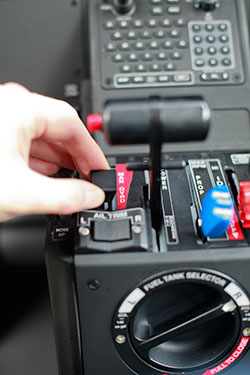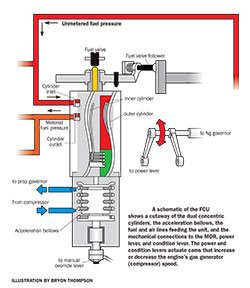System Synopsis
Fuel control manual override (MOR)
Aircraft designers pray at the altar of system redundancy, so virtually all essential aircraft systems come with backups. Of course, that goes double for twins—especially turbine-powered twins. But what about a failure of a single-engine turboprop's sole fuel control unit (FCU)? If it decides to go belly-up the engine will rapidly spool down and summarily quit. Among other cues, you'll detect the onset of an FCU failure by observing drops in the torque, fuel flow, and gas generator rpm. The engine noise level will also be a clue.
October 2011
Turbine Pilot Contents
- Turbine Intro: Make It An Easy Transition: Callouts for safety and managing your turboprop
- The Deal on CJs: Legacy Citations make great buys for economical entry-level jets
- Mentoring Matters: Profiles and Callouts: How jet pilots remember what to do, when
- Systems Synopsis: Fuel Control Manual Override (MOR): When a turboprop single’s fuel control unit fails, it’s time to go manual
The Woodward FCUs used in Daher-Socata TBMs and Pilatus PC-12s are complicated mechanical marvels. They use a design that consists of dual, concentric cylinders that both regulate fuel flow. In normal operations, when you advance or retard the power lever, its mechanical linkage causes the inner cylinder to move laterally within the outer cylinder. This causes two windows—one in the inner cylinder, one in the outer cylinder—to move relative to each other. When the two windows line up perfectly, maximum fuel/power is delivered. At minimum power settings the two windows are less aligned, resulting in less fuel flow. A flexible bellows keeps reference air pressure, which regulates fuel flow according to engine speed. It’s called an acceleration bellows, because it automatically provides an increase in fuel flow as engine speed increases.
 Pull up the MOR lever and move it forward and back to increase or decrease power when the fuel control unit fails.
Pull up the MOR lever and move it forward and back to increase or decrease power when the fuel control unit fails.
If either the bellows springs a leak or a break occurs in the bleed air line, the pressure inside and outside the bellows equalizes, the bellows expands, the inner cylinder rises, the two windows spring to a minimum-aperture position—and power rolls back. This is where manual override (MOR) procedures kick in. Once an uncommanded power drop is confirmed, flight manuals advise pulling the power lever to the Flight Idle position, then unstowing the MOR. Now you’re directly controlling the positions of those two windows, allowing you to restore power. The MOR lever is very sensitive. Small movements can cause large variations in power and large excursions in engine temperature and torque. And with an FCU failure like this, there’s no system to prevent overtorques and overtemps. You are now the torque and temperature governor.
Don’t let gas generator (Ng) speed drop below 75 percent (PC-12s) or 51 percent (TBMs), lest engine speed drop below minimums. Reverse thrust won’t be available for landing because the fuel topping governor is out of the loop.



